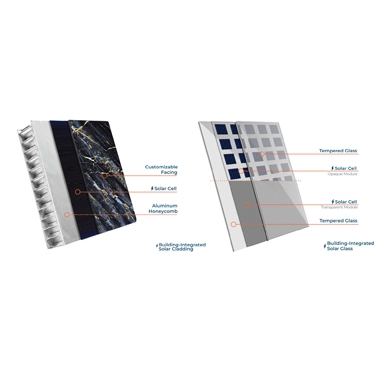
Building Integrated Photovoltaic (BIPV) glass is a type of solar glass designed to seamlessly integrate with architectural elements in buildings while generating electricity. It serves both as a structural component of the building and as a renewable energy source. BIPV glass can be incorporated into various parts of a building, such as windows, facades, roofs, and skylights. These innovative products are typically produced by photovoltaic glass manufacturers or an industrial glass company specializing in advanced glass technologies.
Solar Cell Type | monocrystalline, polycrystalline, and thin-film; |
Max. System Voltage | DC1500W; |
Power Tolerance | 0~+5W; |
Operating Temperatue | -40℃~+85℃; |
Max. Fuse Rated Current | 30A; |
Front Static Load | Snow load 5400Pa, Wind load 2400Pa; |
Packing Data | 31 pcs/Pallet;124(20GP);496(40HQ); |
Maximum Module efficiency | 22.7% ; |
Maximum Power output | 610-635W; |
Product Warranty | 15 years; |
Linear power warranty | 30 years; |
Aesthetic Integration: BIPV glass is designed to blend with the overall aesthetics of the building. It comes in various styles, colors, and transparency levels, allowing architects and designers to incorporate solar technology without compromising the visual appeal of the structure.
Energy Generation: BIPV glass generates electricity by harnessing sunlight through integrated photovoltaic cells. These cells can be thin-film or crystalline silicon-based, and they convert sunlight into electrical power.
Versatility: BIPV glass can be used in different architectural elements, offering flexibility in design and application. It can replace conventional building materials like windows, curtain walls, or skylights, turning them into active components of the energy system.
Sustainable Building Integration: BIPV contributes to sustainable building practices by reducing the reliance on traditional energy sources. It helps in meeting energy efficiency and green building standards by generating clean and renewable energy on-site.
Power Generation Potential: While BIPV glass may not produce as much electricity per square meter as traditional solar panels, its integration into building structures can still make a significant contribution to the overall energy needs of a facility.
Cost and Efficiency: The cost of BIPV glass has been a consideration, but as technology advances and production scales up, costs are expected to decrease. Improvements in efficiency and performance are also ongoing goals in BIPV research and development.
BIPV technology aligns with the broader goal of sustainable and energy-efficient building design, contributing to the reduction of a building's carbon footprint and reliance on non-renewable energy sources.
Pls contact us if you have any inquire or questions, thank you.
No.12111, JINGSHI ROAD, LIXIA DIST, JINAN CITY, SHANDONG PROVINCE, CHINA